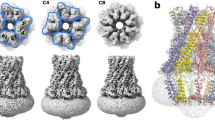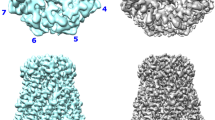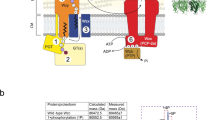Abstract
Long-chain bacterial polysaccharides have important roles in pathogenicity. In Escherichia coli O9a, a model for ABC transporter–dependent polysaccharide assembly, a large extracellular carbohydrate with a narrow size distribution is polymerized from monosaccharides by a complex of two proteins, WbdA (polymerase) and WbdD (terminating protein). Combining crystallography and small-angle X-ray scattering, we found that the C-terminal domain of WbdD contains an extended coiled-coil that physically separates WbdA from the catalytic domain of WbdD. The effects of insertions and deletions in the coiled-coil region were analyzed in vivo, revealing that polymer size is controlled by varying the length of the coiled-coil domain. Thus, the coiled-coil domain of WbdD functions as a molecular ruler that, along with WbdA:WbdD stoichiometry, controls the chain length of a model bacterial polysaccharide.
This is a preview of subscription content, access via your institution
Access options
Subscribe to this journal
Receive 12 print issues and online access
$189.00 per year
only $15.75 per issue
Buy this article
- Purchase on Springer Link
- Instant access to full article PDF
Prices may be subject to local taxes which are calculated during checkout





Similar content being viewed by others
References
Raetz, C.R.H. & Whitfield, C. Lipopolysaccharide endotoxins. Annu. Rev. Biochem. 71, 635–700 (2002).
Whitfield, C. & Trent, M.S. Biosynthesis and export of bacterial lipopolysaccharides. Annu. Rev. Biochem. 83, 99–128 (2014).
Stenutz, R., Weintraub, A. & Widmalm, G. The structures of Escherichia coli O-polysaccharide antigens. FEMS Microbiol. Rev. 30, 382–403 (2006).
Joiner, K.A. Complement evasion by bacteria and parasites. Annu. Rev. Microbiol. 42, 201–230 (1988).
Katsura, I. Mechanism of length determination in bacteriophage lambda tails. Adv. Biophys. 26, 1–18 (1990).
Journet, L., Agrain, C., Broz, P. & Cornelis, G.R. The needle length of bacterial injectisomes is determined by a molecular ruler. Science 302, 1757–1760 (2003).
Greenfield, L.K. & Whitfield, C. Synthesis of lipopolysaccharide O-antigens by ABC transporter–dependent pathways. Carbohydr. Res. 356, 12–24 (2012).
Greenfield, L.K. et al. Biosynthesis of the polymannose lipopolysaccharide O antigens from Escherichia coli serotypes O8 and O9a requires a unique combination of single- and multi-active site mannosyltransferases. J. Biol. Chem. 287, 35078–35091 (2012).
Greenfield, L.K. et al. Domain organization of the polymerizing mannosyltransferases involved in synthesis of the Escherichia coli O8 and O9a lipopolysaccharide O-antigens. J. Biol. Chem. 287, 38135–38149 (2012).
Clarke, B.R., Cuthbertson, L. & Whitfield, C. Nonreducing terminal modifications determine the chain length of polymannose O antigens of Escherichia coli and couple chain termination to polymer export via an ATP-binding cassette transporter. J. Biol. Chem. 279, 35709–35718 (2004).
Clarke, B.R., Greenfield, L.K., Bouwman, C. & Whitfield, C. Coordination of polymerization, chain termination, and export in assembly of the Escherichia coli lipopolysaccharide O9a antigen in an ATP-binding cassette transporter-dependent pathway. J. Biol. Chem. 284, 30662–30672 (2009).
Clarke, B.R. et al. In vitro reconstruction of the chain termination reaction in biosynthesis of the Escherichia coli O9a O-polysaccharide: the chain-length regulator, WbdD, catalyzes the addition of methyl phosphate to the non-reducing terminus of the growing glycan. J. Biol. Chem. 286, 41391–41401 (2011).
Cuthbertson, L., Kimber, M.S. & Whitfield, C. Substrate binding by a bacterial ABC transporter involved in polysaccharide export. Proc. Natl. Acad. Sci. USA 104, 19529–19534 (2007).
Cuthbertson, L., Mainprize, I.L., Naismith, J.H. & Whitfield, C. Pivotal roles of the outer membrane polysaccharide export and polysaccharide copolymerase protein families in export of extracellular polysaccharides in gram-negative bacteria. Microbiol. Mol. Biol. Rev. 73, 155–177 (2009).
Hagelueken, G. et al. Structure of WbdD: a bifunctional kinase and methyltransferase that regulates the chain length of the O antigen in Escherichia coli O9a. Mol. Microbiol. 86, 730–742 (2012).
King, J.D., Berry, S., Clarke, B.R., Morris, R.J. & Whitfield, C. Lipopolysaccharide O antigen size distribution is determined by a chain extension complex of variable stoichiometry in Escherichia coli O9a. Proc. Natl. Acad. Sci. USA 111, 6407–6412 (2014).
Hagelueken, G. et al. Crystallization, dehydration and experimental phasing of WbdD, a bifunctional kinase and methyltransferase from Escherichia coli O9a. Acta Crystallogr. D Biol. Crystallogr. 68, 1371–1379 (2012).
Schröder, G.F., Levitt, M. & Brunger, A.T. Super-resolution biomolecular crystallography with low-resolution data. Nature 464, 1218–1222 (2010).
Lupas, A.N. & Gruber, M. The structure of α-helical coiled coils. Adv. Protein Chem. 70, 37–38 (2005).
Grigoryan, G. & DeGrado, W.F. Probing designability via a generalized model of helical bundle geometry. J. Mol. Biol. 405, 1079–1100 (2011).
Strelkov, S.V. & Burkhard, P. Analysis of α-helical coiled coils with the program TWISTER reveals a structural mechanism for stutter compensation. J. Struct. Biol. 137, 54–64 (2002).
Wood, C.W. et al. CCBuilder: an interactive web-based tool for building, designing and assessing coiled-coil protein assemblies. Bioinformatics 30, 3029–3035 (2014).
Petoukhov, M.V. & Svergun, D.I. Global rigid body modeling of macromolecular complexes against small-angle scattering data. Biophys. J. 89, 1237–1250 (2005).
van Stokkum, I.H., Spoelder, H.J., Bloemendal, M., van Grondelle, R. & Groen, F.C. Estimation of protein secondary structure and error analysis from circular dichroism spectra. Anal. Biochem. 191, 110–118 (1990).
Sreerama, N. & Woody, R.W. Estimation of protein secondary structure from circular dichroism spectra: comparison of CONTIN, SELCON, and CDSSTR methods with an expanded reference set. Anal. Biochem. 287, 252–260 (2000).
King, J. Bacteriophage T4 tail assembly: four steps in core formation. J. Mol. Biol. 58, 693–709 (1971).
Marshall, W.F. Cellular length control systems. Annu. Rev. Cell Dev. Biol. 20, 677–693 (2004).
Makishima, S., Komoriya, K., Yamaguchi, S. & Aizawa, S.-I. Length of the flagellar hook and the capacity of the type III export apparatus. Science 291, 2411–2413 (2001).
Erhardt, M., Singer, H.M., Wee, D.H., Keener, J.P. & Hughes, K.T. An infrequent molecular ruler controls flagellar hook length in Salmonella enterica. EMBO J. 30, 2948–2961 (2011).
Agrain, C., Sorg, I., Paroz, C. & Cornelis, G.R. Secretion of YscP from Yersinia enterocolitica is essential to control the length of the injectisome needle but not to change the type III secretion substrate specificity. Mol. Microbiol. 57, 1415–1427 (2005).
Wagner, S., Stenta, M., Metzger, L.C., Dal Peraro, M. & Cornelis, G.R. Length control of the injectisome needle requires only one molecule of Yop secretion protein P (YscP). Proc. Natl. Acad. Sci. USA 107, 13860–13865 (2010).
Wagner, S. et al. The helical content of the YscP molecular ruler determines the length of the Yersinia injectisome. Mol. Microbiol. 71, 692–701 (2009).
Hatoum-Aslan, A., Samai, P., Maniv, I., Jiang, W. & Marraffini, L.A. A ruler protein in a complex for antiviral defense determines the length of small interfering CRISPR RNAs. J. Biol. Chem. 288, 27888–27897 (2013).
Hinz, A. et al. Structural basis of HIV-1 tethering to membranes by the BST-2/tetherin ectodomain. Cell Host Microbe 7, 314–323 (2010).
Kim, J.-S. et al. Crystal structure of DNA sequence specificity subunit of a type I restriction-modification enzyme and its functional implications. Proc. Natl. Acad. Sci. USA 102, 3248–3253 (2005).
Price, C., Lingner, J., Bickle, T.A., Firman, K. & Glover, S.W. Basis for changes in DNA recognition by the EcoR124 and EcoR124/3 type I DNA restriction and modification enzymes. J. Mol. Biol. 205, 115–125 (1989).
Kido, N., Sugiyama, T., Yokochi, T., Kobayashi, H. & Okawa, Y. Synthesis of Escherichia coli O9a polysaccharide requires the participation of two domains of WbdA, a mannosyltransferase encoded within the wb* gene cluster. Mol. Microbiol. 27, 1213–1221 (1998).
Kubler-Kielb, J., Whitfield, C., Katzenellenbogen, E. & Vinogradov, E. Identification of the methyl phosphate substituent at the non-reducing terminal mannose residue of the O-specific polysaccharides of Klebsiella pneumoniae O3, Hafnia alvei PCM 1223 and Escherichia coli O9/O9a LPS. Carbohydr. Res. 347, 186–188 (2012).
Steiner, K. et al. Molecular basis of S-layer glycoprotein glycan biosynthesis in Geobacillus stearothermophilus. J. Biol. Chem. 283, 21120–21133 (2008).
Vinogradov, E. et al. Structures of lipopolysaccharides from Klebsiella pneumoniae. Eluicidation of the structure of the linkage region between core and polysaccharide O chain and identification of the residues at the non-reducing termini of the O chains. J. Biol. Chem. 277, 25070–25081 (2002).
Mertens, K. et al. Antiserum against Raoultella terrigena ATCC 33257 identifies a large number of Raoultella and Klebsiella clinical isolates as serotype O12. Innate Immun. 16, 366–380 (2010).
Abràmoff, M.D., Magalhães, P.J. & Ram, S.J. Image processing with ImageJ. Biophotonics Int. 11, 36–42 (2004).
Winter, G. xia2: an expert system for macromolecular crystallography data reduction. J. Appl. Cryst. 43, 186–190 (2010).
McCoy, A.J. et al. Phaser crystallographic software. J. Appl. Cryst. 40, 658–674 (2007).
Nicholls, R.A., Long, F. & Murshudov, G.N. Low-resolution refinement tools in REFMAC5. Acta Crystallogr. D Biol. Crystallogr. 68, 404–417 (2012).
Chen, V.B. et al. MolProbity: all-atom structure validation for macromolecular crystallography. Acta Crystallogr. D Biol. Crystallogr. 66, 12–21 (2010).
Roessle, M.W. et al. Upgrade of the small-angle X-ray scattering beamline X33 at the European Molecular Biology Laboratory, Hamburg. J. Appl. Crystallogr. 40, 190–194 (2007).
Petoukhov, M.V., Konarev, P.V., Kikhney, A.G. & Svergun, D.I. ATSAS2.1 – towards automated and web-supported small-angle scattering data analysis. J. Appl. Crystallogr. 40, 223–228 (2007).
Konarev, P.V., Volkov, V.V., Sokolova, A.V., Koch, M.H.J. & Svergun, D.I. PRIMUS: a Windows PC-based system for small-angle scattering data analysis. J. Appl. Crystallogr. 36, 1277–1282 (2003).
Guinier, A. La diffraction des rayons X aux tres petits angles: applications a l'etude de phenomenes ultramicroscopiques. Ann. Phys. (Paris) 12, 161–237 (1939).
Svergun, D.I. Determination of the regularization parameter in indirect-transform methods using perceptual criteria. J. Appl. Crystallogr. 25, 495–503 (1992).
Petoukhov, M.V. et al. New developments in the ATSAS program package for small-angle scattering data analysis. J. Appl. Crystallogr. 45, 342–350 (2012).
Svergun, D., Barberato, C. & Koch, M.H.J. CRYSOL– a program to evaluate X-ray solution scattering of biological macromolecules from atomic coordinates. J. Appl. Crystallogr. 28, 768–773 (1995).
Svergun, D.I. Restoring low resolution structure of biological macromolecules from solution scattering using simulated annealing. Biophys. J. 76, 2879–2886 (1999).
Kozin, M.B. & Svergun, D.I. Automated matching of high- and low-resolution structural models. J. Appl. Crystallogr. 34, 33–41 (2001).
Volkov, V.V. & Svergun, D.I. Uniqueness of ab initio shape determination in small-angle scattering. J. Appl. Crystallogr. 36, 860–864 (2003).
Jávorfi, T., Hussain, R., Myatt, D. & Siligardi, G. Measuring circular dichroism in a capillary cell using the b23 synchrotron radiation CD beamline at diamond light source. Chirality 22 Suppl 1, E149–E153 (2010).
Hussain, R., Jávorfi, T. & Siligardi, G. Spectroscopic analysis: synchrotron radiation circular dichroism. in Comprehensive Chirality (eds. Yamamoto, H. & Carriera, E.M.) 438–448 (Elsevier, 2012).
Hussain, R., Jávorfi, T. & Siligardi, G. Circular dichroism beamline B23 at the diamond light source. J. Synchrotron Radiat. 19, 132–135 (2012).
Liu, H. & Naismith, J.H. An efficient one-step site-directed deletion, insertion, single and multiple-site plasmid mutagenesis protocol. BMC Biotechnol. 8, 91 (2008).
Whitfield, C., Schoenhals, G. & Graham, L. Mutants of Escherichia coli O9: K30 with Altered synthesis and expression of the capsular K30 antigen. J. Gen. Microbiol. 135, 2589–2599 (1989).
Hitchcock, P.J. & Brown, T.M. Morphological heterogeneity among Salmonella lipopolysaccharide chemotypes in silver-stained polyacrylamide gels. J. Bacteriol. 154, 269–277 (1983).
Tsai, C.M. & Frasch, C.E. A sensitive silver stain for detecting lipopolysaccharides in polyacrylamide gels. Anal. Biochem. 119, 115–119 (1982).
Acknowledgements
This work was supported by Wellcome Trust grant 081862 (J.H.N. and C.W.), Senior Investigator Award WT100209MA (J.H.N.), the Natural Sciences, Engineering Research Council of Canada (C.W.), and the German Federal Ministry of Education and Research (BMBF) project BioSCAT (contract no: 05K12YE1 (A.T. and D.I.S.). J.H.N. is a Royal Society Wolfson Merit Award Holder and C.W. is a recipient of a Canada Research Chair. We are grateful for beam time on beam lines B23 and IO4 at Diamond and on the beam line X33 of the EMBL at DESY.
Author information
Authors and Affiliations
Contributions
G.H., H.H. and J.H.N. carried out the crystallography. A.T., I.D. and D.I.S. carried out SAXS experiments, data analysis and modeling. B.R.C., H.L. and C.W. carried out mutagenesis and in vivo work. H.H. and R.H. carried out CD experiments. All of the authors analyzed data and contributed to writing the paper.
Corresponding authors
Ethics declarations
Competing interests
The authors declare no competing financial interests.
Integrated supplementary information
Supplementary Figure 1 SAXS data for WbdD1–459 monomer.
Two views (rotated by 90°) of an ab initio model constructed using DAMMIN is shown in the bottom left (grey surfaces). The high-resolution structure of WbdD1-459 shown as cartoon model (purple) is superimposed. Fits of the structural model against the experimental SAXS data (open circles with error bars representing s.d. computed from propagated Poisson counting statistics).
Supplementary Figure 2 Prediction of coiled-coil structures in the C-terminal part of WbdD.
The part of the coiled-coil that has been observed in the low-resolution WbdD1-556 structure (residues up to 506 ordered) is shaded in grey.
Supplementary Figure 3 CD spectra of different WbdD constructs recorded on Diamond beamline B23.
See main text for experimental details and discussion. The experimental helical content and the expected increase with respect to WbdD1-459 (based on the number of inserted or deleted residues) are detailed below the spectra.
Supplementary Figure 4 Effect of His6-WbdD expression level on the chain length of the E. coli O9a O-polysaccharide.
E. coli O9a ΔwbdD [pWQ470] cultures where grown to mid-exponential phase in LB medium containing 0.1% (w/v) D-mannose and varying L-arabinose concentrations (as indicated). Cells equivalent to one A600nm unit were collected from each culture and lysed in SDS-PAGE loading buffer. One half of each sample was treated with proteinase K, separated by SDS-PAGE and the LPS stained with Emerald Pro Q (Life Technologies). The remaining half was separated by SDS-PAGE and His6-WbdD was detected by Western blotting using anti-Penta-His antibody (Qiagen) together with horseradish peroxidase-conjugated goat-anti mouse antibody (Cedar Lane) and Luminata Classico Western HRP substrate (Millipore). Protein levels were quantitated by densitometry and are reported below the figure as the amounts relative to that observed in the sample with the highest expression level (0.05% L-arabinose).
Supplementary Figure 5 Chain length of LPS with mutant WbdD protein.
A) Silver-stained SDS-PAGE showing an incremental decrease in LPS chain-length when His6-WbdD ∆(GHIJ) and (CDEF)2 were over-expressed from the pBAD promoter with various L-arabinose concentrations. In both cases genomic WbdA was constitutively expressed from its native promoter.
B) Plot of LPS length in RU (taken from Figure 3C) versus calculated coiled-coil domain length (taken from Figure 3A). The red line is a linear regression of the plot. The regression parameters are given in the plot.
Supplementary Figure 6 Diagram showing the relative positions of coiled-coil regions within established and putative glycan chain–terminating enzymes.
WbdDO9a and WbdDO8 (GenBank AFQ31610 and BAA28326) possess terminating activity only. The putative coiled-coil of G. stearothermophilus WsaE (ARR99608) separates a chain-terminating methyltransferase domain from two glycosyltransferase domains involved in polysaccharide elongation. The R. terrigena WbbB (AAQ82931) protein has a putative 3-deoxy-D-manno-oct-2-ulosonic acid transferase (pfam05159) domain and two glycosyltransferase domains (pfam 13524 and 01755) separated by a coiled-coil. The putative coiled-coil regions for WbdDO8, WsaE, and WbbB were identified using the COILS program with a window of 28 residues.
Supplementary information
Supplementary Text and Figures
Supplementary Figures 1–6 and Supplementary Tables 1 and 2 (PDF 2314 kb)
Rights and permissions
About this article
Cite this article
Hagelueken, G., Clarke, B., Huang, H. et al. A coiled-coil domain acts as a molecular ruler to regulate O-antigen chain length in lipopolysaccharide. Nat Struct Mol Biol 22, 50–56 (2015). https://doi.org/10.1038/nsmb.2935
Received:
Accepted:
Published:
Issue Date:
DOI: https://doi.org/10.1038/nsmb.2935
This article is cited by
-
A lipid gating mechanism for the channel-forming O antigen ABC transporter
Nature Communications (2019)
-
Structural basis of the molecular ruler mechanism of a bacterial glycosyltransferase
Nature Communications (2018)
-
Single-pot glycoprotein biosynthesis using a cell-free transcription-translation system enriched with glycosylation machinery
Nature Communications (2018)
-
Cyclic-di-GMP regulates lipopolysaccharide modification and contributes to Pseudomonas aeruginosa immune evasion
Nature Microbiology (2017)



